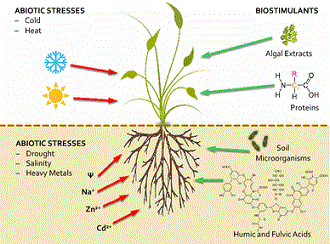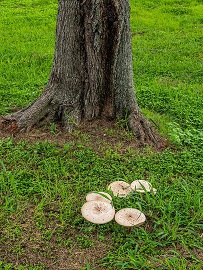This book is what a review should be all about: lengthy (365 pg), thorough, several tables and hundreds of references. Overall, this is a complete book on a highly relevant topic. Biostimulants: natural substances supporting vegetative growth, uptake of nutrients, tolerance to abiotic stress by roots and plant tolerance to drought and salt stress.

Feeding 10 billion people
Providing food to 10 billion people in a sustainable way on a flourishing planet is a formidable challenge, triggering numerous new research topics. This challenge is intensified even further as previous methods either don’t work sufficiently enough, or don’t work at all. Traditional methods based on a reductionistic approach have brought us where we are now. Products such as fertilizers and plant protection agents were always single (molecular) entities. They were well defined, easy to identify and protectable by a patent. However since then, we have discovered the need to rely on more holistic approaches, and those working in agricultural science were one of the first to learn about this. Modern biotechnology has shown that the life of plants is managed by a complete world on its own wherein no entity is of dominant importance. Balancing thousands of molecules, molecular complexes and living micro-organisms in a continuous search for an optimal equilibrium with the plants own complexity is now the newest challenge.
This is the focus of the new title, Biostimulants for sustainable crop production. The book isn’t dedicated to a discussion on the development of more effective fertilizers or more subtle protection agents. Instead, it provides comprehensive discussions on the complex compositions that stimulate the plant’s well-being; from seed to plant and crop. Using seaweed as a biostimulant is a well-discussed topic throughout the book, and one that is extremely suited to show the complexity and difficulties that can arise with the holistic approach. The same principle exists for humic substances, protein hydrosylates and even more so for bacteria and fungi. The common thread? They’re all products with an ill-defined molecular identity. Even an apparently simple element such as silicium does its stimulating work in molecular forms that we still cannot fully comprehend.

Biostimulants, the next phase in agriculture
The book starts with the legal definition of biostimulants. As market potential is growing, there is a greater need for well-defined products. As it currently stands, only the EU has a workable definition based on what biostimulants can do, as opposed to what they are. espite this, patent protection and quality control remain large issues that need to be resolved for the sector to continue in its advancement. Parts 1 and 2 of this new title, discuss the state of the art in product analysis, research on action models, and the application and marketing of the five biostimulants. The final part of the book features two industrial case studies on mycorrhizal inoculants and vegetal-based protein hydrolysates that are extremely informative. The focus of the final chapter is on combining biostimulants with precision agriculture. This is an exciting prospect that gives us a glimpse as to what providing food for future generations may look like.
The overall message of the book is far reaching. The limitations of the molecular approach become quite clear. Whereas most studies are based on identifying the molecules that exert the stimulating effects, the conclusion seemingly tends to be that complex interactions are the real cause and that further research is needed. Most studies have a reductionistic approach, whereas it is unlikely that a single unified explanation for the beneficial effects will be identified. Hence it is imperative that each development undergoes careful and well-replicated field testing. Laboratory work and greenhouse studies may well be greatly insufficient in developing a successful product. The development of precise monitoring, dedicated sensors, big data processing and omics-methods (all applicable in field trials), may be deemed as a more sufficient method to employing laboratory and greenhouse facilities.
To conclude, this book is a preview of a new era in agricultural development that brings along excitement and vast potential to tackle the challenge of feeding a growing population sustainably.
Bio-stimulants for sustainable crop production. Edited by Yoessef Rouphael, Patrick du Jardin, Patrick Brown, Stefania De Pascale and Giuseppe Colla. Burleigh Dodds series in agricultural science, 2020. ISBN 9781786763365.
Interesting? Then also read:
Healthy soils for a productive bioeconomy
Reconnect with nature – the new sustainability
Circular agriculture, the model of the future
